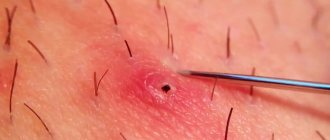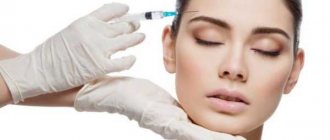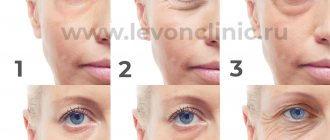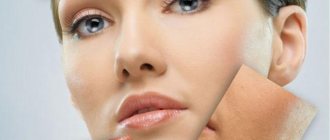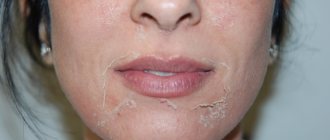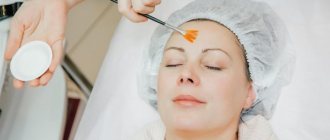After the peeling procedure, many people encounter problems such as redness and itching on the face. But, despite this, such a cosmetic procedure is in demand and there are people who want to undergo it. After all, not every woman can fall into the category of those who will have such a reaction as a red face or itchy skin.
Not everyone knows how to deal with this, what to do before the procedure itself to minimize the risk. Let's try to understand in detail the reasons and how to avoid this.
Deep peeling is equivalent to a skin burn and takes time to regenerate; the final effect will not be immediate
About the peeling procedure
Every woman wants to stay young as long as possible and the condition of her skin, especially her facial skin, should not reveal her age. This is why most women resort to cosmetic peeling, of which there are three types:
- deep;
- average;
- surface.
Each of these types of cosmetic procedures is designed for a specific skin type and targets a specific problem. These could be age-related changes, enlarged pores, pigmentation, and so on. An incorrectly selected procedure can cause unpleasant symptoms such as red facial skin, itching or peeling.
Why does this happen, what can we do about it, why does the skin suffer so much?
There is no need to rush to the nearest salon; you can safely carry out preparatory activities at home. And here an important factor is the right chosen salon, where real professionals work. Only people with extensive experience and knowledge can correctly determine how ready the skin is and whether its type is suitable in order to carry out the procedure painlessly and with the least consequences.
Preparatory activities are no less important. Indeed, ideally, peeling, itching or redness can be observed only for a short period of time after the procedure. And as a rule, such consequences are not visible for several days. The redness is temporary, but the result is healthy and glowing skin.
What to do with the skin after the procedure
Active acids are used during peeling. They, penetrating deep into the skin, trigger metabolic and regenerative processes of cells. This is a slightly stressful situation for the skin, which results in flaking and itching, as well as possible swelling. This is normal, but if it does not go away after seven days, you should immediately contact a cosmetologist or the salon where the cosmetic procedure was performed. There is no need to run to your previous cosmetologist in the salon. In such a situation, it is best to consult a dermatologist at the clinic.
If the symptoms do not go away, then the salon has committed violations. And there is no likelihood that they will really be able to help. Here it is better to contact another specialist and present the result obtained to the cosmetologist who performed the peeling. Then there is a chance that the salon or beauty clinic will pay for damages. If not, then the results can be brought to court along with the claim.
Cosmetologists will tell you how to avoid spots on your face
The procedure has unpleasant accompanying aspects, which include redness, itching, peeling and increased sensitivity of the epidermis. But they are short-lived and disappear within 2 hours. Sometimes they finally go away after about 4 days, but these side effects should not cause much discomfort if the procedure is performed correctly.
If peeling was carried out at home or proper facial care was not followed after a professional procedure, then more severe complications cannot be avoided. There are rare cases when serious complications arise due to the inexperience of the cosmetologist performing the procedure in the salon.
In order to reduce the likelihood of complications, you need to follow some advice given by cosmetologists:
- first of all, when going to a specific beauty salon, you need to find out as much as possible about this establishment, read reviews on the Internet, ask your friends. This is important in order to eliminate the risk of falling into the hands of an unqualified cosmetologist;
- You should not carry out the chemical peeling procedure yourself for the first time. It’s better to go to a salon, where a specialist will answer your questions, explain important points and tell you how to correctly carry out this procedure step by step. Also in the salon you will feel the results for yourself;
- you need to find out if there are any allergies to the substances used;
- It is necessary to study in detail all contraindications to the procedure. It is worth noting that girls who are planning a pregnancy in the near future or are already pregnant. And also during lactation, you cannot use yellow, also known as retinoic, peeling. And those who have very sensitive skin should avoid dairy products;
- The first days after, the skin does not look very attractive, and you should not stay in the sun for too long. During the course, as well as a few days after, it is recommended to be outside as little as possible, so we advise you to take a few extra days off from work.
What not to do after peeling
Practitioner cosmetologist Olga Kritsina talks about typical mistakes after chemical peeling that you should absolutely not do:
- Do not roll or scrub the skin after peeling;
- do not use aggressive skincare cosmetics, especially in the first 5 days;
- be sure to use sunscreen from 25-30-50 SPF;
- no BB creams;
- do not tear off the skin;
- Do not confuse hydration with nutrition. Nivea and Vichu creams are not your option;
- micellar water and tonic lotion are two different things;
- if you don’t have the money, then buy regular Vaseline, but not aggressive agents;
- You can’t go outside without SPF protection.
Read also: Essential oils for the face
TCA PEELING based on trichloroacetic acid
What is a TCA peel?
TCA peeling is the application of trichloroacetic acid to the skin to even out the texture and color of the skin. This peeling can be both superficial (light peeling) and medium (brown crusts that disappear within 7-10 days), it all depends on what effect you want to achieve, how many layers to apply, what % of acid, how long to keep the composition on the skin .
Today we’ll talk about TCA PEELING based on trichloroacetic acid. Peeling is very cool! It amazingly evens out the skin, removes scars, makes the skin fresh and evens out wrinkles. After it, the skin color is simply amazing. But this is a peeling whose nuances cannot be ignored. You should know them!
The TCA peeling procedure is designed to go deeper into the middle layers of the skin on the face, smoothing and stimulating the skin to renew itself. Acid, when applied to the skin, is very aggressive and causes pain. The procedure is painful.
Painfulness of the procedure
TCA peeling is very painful, because it is, first of all, an acid. Acid applied to the face is a chemical burn. The burn can be of varying degrees: superficial and median. It can reach the deep layers of the skin.
If you have a very low pain threshold and you perceive any pain as very strong and cannot tolerate it, then you need to think 10 times before deciding to take TCA. This is a short, quick procedure and very little time passes between the first application of the acid and the moment when we neutralize it (3-4 minutes). But you just have to survive these 3-4 minutes, it really hurts! Patients with a high pain threshold tolerate this procedure well. I do not accept patients with a low pain threshold for this procedure.
Rehabilitation after TCA peeling
The TCA procedure has a long recovery time. The middle peel will be quite deep and you must understand that you won’t be able to go to a wedding the next day or take a super selfie on Instagram in a couple of days.
For the first three days after the procedure, you will sit at home with a tightening red-brown film on your face. You will need to do home care and moisturize your skin well so that the rehabilitation process goes as expected and the peeling is as effective as possible. Therefore, do not plan anything for the next few days after peeling; rehabilitation time takes 7-10 days.
Indications for the procedure
TCA peeling is used to solve various problems: scars, post-acne, fine wrinkles and aging skin. But very often women come to this peeling with age spots. Pigment spots can be both an indication for this peeling and a contraindication for it. Why? Because there is different pigmentation. And it should be classified by a cosmetologist (dermatologist).
TCA peeling is indicated:
- Pigmentation occurred during pregnancy
- Pigmentation appeared after 40 years, or from intense exposure to the sun (solarium).
- Pigmentation changes intensity from light to dark and vice versa depending on the season.
TCA peeling is likely to lighten this pigmentation and even out the tone of the face.
TCA peeling is contraindicated:
- If the pigmentation is post-inflammatory
- Appears after rashes or damage to the skin (by hands, aggressive procedures)
This means you have a tendency to post-inflammatory pigmentation and pigmentation due to damage. In this case, TCA pilin will be contraindicated for you, because the burn that we will create with this peeling on the face can provoke reactive pigmentation and it will be very difficult to get rid of it.
Skin condition after TCA peeling
The skin will be more receptive to all serums and all homemade creams. After acid exposure, the skin is renewed, young skin grows and it must be protected from the sun, because due to insufficient natural protection, it can again give you pigmentation. The skin must be soothed with special products. The first time after peeling, the skin will be slightly pinkish and more sensitive than before, until a period of complete healing has passed.
Review of TCA peeling
TCA is a very good peeling and, compared to hardware leveling techniques, it is the most inexpensive and very effective. I really like to use it in my work and combine it with various techniques: biorevitalization, peptides, etc.
It is important to take into account all the points that I told you about. If you pay attention to them, then this peeling can be harmful, like any other procedure that is not done according to the instructions of the attending physician or does not follow the rules!
My patients very often ask: Is it possible to replace one TCA with several superficial peels? It would seem that it is much easier to undergo a light rehabilitation period several times than to sit at home once (7-10 days) with scabs on your face. I would be happy to say that it is possible, but unfortunately not. Going to the dermis once or sanding the surface of the skin 10 times are completely different things. This is a completely different leveling effect and a completely different stimulating effect.
TCA Peeling – Results
TCA peeling has an excellent smoothing effect, but it is important to remember that one TCA peeling procedure is not enough to achieve a good effect of smoothing the skin texture. You need to take a course of peelings, and sometimes several courses. In one season you come 1-4 times, in another season 1-4 times and combine with other procedures that help restore the skin during rest periods between TCA peels. Skin smoothing is a long and tedious process, which will certainly give great results if you are patient.
Author of the article: Yuliana Shiyan
Share this post
Consequences that should not cause panic
Many people don’t know what to do next after peeling and simply panic when they see their reflection in the mirror in the first days. There is no need to remind you that there should be no panic. Here are presented phenomena that are typical specifically for the first days.
Peeling
To begin with, it is worth noting that the word peeling itself in translation means peeling. Accordingly, this is a completely understandable reaction of the facial skin. Another question is how long this phenomenon will last. On average, depending on the type chosen, recovery takes from two to seven days.
Red face
This is also a natural skin reaction. During the procedure, the skin receives a kind of burn and redness, even swelling; this is nothing more than a small burn of the skin. But, it is absolutely painless. A film forms on the surface of the skin, which is later replaced by a crust. Just like this happens with thermal burns or after prolonged exposure to the sun. The duration of redness depends on the complexity of the procedure itself and the depth of penetration into the epidermis.
Edema
Those with thin skin usually suffer this fate. This is not considered unusual for peeling, so it should not cause panic. The swelling will go away in a few days, as will other obvious signs.
NO PANIC! WHEN REDDERNESS IS NORMAL
According to doctors, in most cases the face burns due to inflammatory processes, that is, redness is quite expected.
In the epidermis and dermis, the number of immunocompetent cells that produce inflammatory mediators: histamine and interleukins increases.
The vascular wall becomes thinner, blood plasma leaks into the space between the cells.
This is how the so-called “pasty” (pre-edema state), or redness, occurs.
Most often the reason is too thin skin. Most often, those with a thin type of epidermis are more likely than others to worry about how to remove redness, how to relieve swelling and irritation:
- after yellow peeling,
- TCA,
- exfoliation with fruit aha acids.
TCA Eraser from TOSCANI COSMETICS (8% phenol)
These symptoms are most pronounced in places where the epidermis is especially thin: for example, on the eyelids or on the neck. There, swelling and redness are especially pronounced.
This is normal, no need to worry . If there are no pronounced painful sensations, then everything is in order.
At the next stage, the red face will be covered with a film, then the film will turn into a crust, and under the crust there will be normal skin.
This happens for natural reasons: for example, due to sunburn or any other thermal. Serious complications after peeling manifest themselves differently.
Consequences of peeling that should alert you
Pimples
Such a manifestation can occur due to a violation of the procedure itself, or due to improper subsequent care of the facial skin after peeling. In this situation, it is best to seek help from the cosmetologist who prescribed the procedure or from a dermatologist at the clinic. As a rule, antibacterial agents are prescribed that contain zinc and acne disappears quickly.
Wounds and scabs
There is no cause for concern if the skin is crusted over. Under no circumstances should it be peeled off or soaked. If this is not observed, then such actions will lead to the appearance of scars and unevenness. In a few days it will fall off on its own.
Pigmentation
Here it is necessary to recall that peeling is a seasonal procedure and cannot be carried out during periods of high solar activity. That is, spring and summer are not particularly suitable for carrying out such a cosmetic procedure, and it is best to postpone it until autumn or winter. Also, pigmentation increases without the use of SPF protection during the period of skin restoration.
Cause of red spots and itching
Red spots after peeling can be called normal, because the chemicals and substances used cause just such a reaction. Often, redness appears immediately after the facial cleansing procedure, and disappears after approximately 3 hours from the moment of cessation. But there are times when the redness goes away only after a few days. The duration and intensity of facial redness depends on the individual characteristics of the skin, highly sensitive skin and the concentration of the product used for peeling.
Itching on the face appears on the 2nd or 3rd day and lasts from 2 to 5 days. If it is irritating and difficult to tolerate, you can apply a cold compress to your face or take an antihistamine. Next, you will need to keep your skin moisturized and take anti-allergy medications to relieve itching.
Severe redness after deep peeling, including glycolic peeling. This skin reaction is caused by dilation of blood vessels located close to the surface of the skin, called persistent erythema.
How to avoid the negative effects of peeling
In order to avoid negative consequences and not get disappointment instead of the desired result, preparation for this procedure must begin before it is carried out. And one consultation with a cosmetologist is not enough here.
Any external intervention in the upper layers of the epidermis is stressful for it and for the skin itself. The cosmetologist should definitely focus on this at the first consultation, and there should be at least two of them. And the choice of a salon or clinic should not be spontaneous. If you don’t want to visit the clinic often, you can find information on the Internet. But you still have to make a couple of preliminary visits.
Cosmetologist, chief physician of the Euromedica aesthetic medicine clinic Elena Kudashkina answers questions about the rules of rehabilitation after peeling in the video:
Predicted side effects
The peeling process occurs by exposing the skin to a laser. As a result, the body experiences very severe stress. Old cells are removed, and the skin is renewed thanks to natural processes. Because dead cells accumulate in the pores and prevent the skin from breathing normally. Thus, by removing problem layers, the skin is again saturated with nutrients and oxygen.
The skin may experience consequences after facial peeling, and the laser treatment area will begin to peel off. This is a natural process. But for each predicted side effect there is a separate treatment method. Don't panic; it's better to follow your doctor's instructions.
Erythema
Redness of the area of skin that was treated with the laser. And the stronger the impact of the beam, the more clearly the symptoms will appear. It is also necessary to take into account the sensitivity of the patient's skin. People with this diagnosis are susceptible to this complication.
If the clinic uses a superficial technique that involves fruit acids, then the redness lasts for several hours. But after a deep Jessner cleanse, these symptoms do not go away for two to three days.
Erythema after using medium acid exfoliations can last from 3 to 5 days. But there are methods after which redness of the skin can be observed from a week to a month. For example, deep cleansing or dermabrasion.
Edema
They appear due to the structural features of blood vessels. If they have increased permeability, then after laser treatment, fluid begins to release and accumulate from the vessels, which forms edema. Most often, symptoms are observed on the face, where there are sensitive areas.
However, the swelling itself does not appear immediately. The patient begins to notice complications the next day. Sometimes symptoms appear after 3 days.
To avoid this effect, the cosmetologist must calculate the harmless concentration of the acidic product. But for this you need to have a lot of experience.
Peeling
This is a necessary side effect. After treating an area of skin with a laser, cells begin to divide and renew themselves. Therefore, the more intense the peeling, the better for the skin. As a result, the upper layers of the epidermis begin to peel off and become very itchy. But at the same time, it is forbidden to touch it or rip off the sagging areas.
Cosmetologists recommend rubbing in special preparations that will heal wounds and moisturize the skin at the same time.
Darkening of the skin
As the chemical peeling was carried out, the skin begins to darken in some areas. But this is a natural process and there is no reason to worry. These are formations of old cells that will disappear after exfoliation.
Skin hypersensitivity
The effects of peeling can cause severe pain when touched. The skin becomes very sensitive and the patient feels this even when washing with warm water or while putting on makeup.
This complication manifests itself individually. Sometimes it ends in a week, and sometimes the symptoms last up to a year. This occurs because soft tissue loses its protection after exfoliation. Sensitivity increases and the UV barrier decreases.
In this case, doctors recommend applying sunscreen before going outside on a bright sunny day or performing the procedure in winter or autumn, when ultraviolet radiation is not so active.
TOP 10 recommended post-peeling products
Bepanten
A popular pharmaceutical remedy that helps cope with redness and a feeling of tightness. It accelerates skin regeneration and improves the protective layer of the skin. Contains almond oil and beeswax.
The cream has a soft texture and does not clog pores, allowing the skin to breathe. Absorbs quickly and leaves no greasy residue. Its use is recommended after chemical or mechanical peeling. It needs to be applied twice a day for 4-7 days.
Solcoseryl
Suitable for all skin types and applied after a chemical peeling procedure. It can be applied to skin suffering from seborrhea. The composition contains a dialysate substance, which is obtained from the blood of calves.
The cream relieves pain, actively nourishes, moisturizes and normalizes metabolic processes. Helps the skin produce collagen. Suitable for women over 35 years of age. It should be used situationally if rashes and peeling appear after peeling.
Depanthenol
This is a budget version of Bepanten and has almost the same composition. Suitable for skin care after deep peeling. Depending on the assistance needed, the product is chosen in the form of a cream, ointment or spray. It moisturizes, softens and heals the skin. Increases its protective functions.
Read also: Top 15 best Urban Decay products
Before application, the face is treated with an antiseptic. Since Depanthenol forms a protective film on the skin, it is recommended to apply it in the morning.
Traumeel
The ointment contains chamomile, St. John's wort, calendula and yarrow. It has an analgesic effect and fights inflammation. In the shortest possible time relieves itching, reduces redness and eliminates tightness.
Suitable after using any type of peeling, it helps in a short time.
MedicControl Peel, Vegefarma cream
A cream developed specifically for post-peeling care. Contains chamomile, sunflower and rapeseed oil. In a short time it eliminates inflammation, moisturizes and has a bactericidal effect on the skin.
Within 3-4 days it will help get rid of tightness and severe redness.
Kanebo Sensai Silk Soothing Cream
Cream with a light and delicate texture. Has intense hydration and softening effect. Easily and quickly absorbed without leaving any traces on the skin. Contains minerals and plant extracts.
Provides comprehensive care during the post-peeling period. Quickly copes with wounds and itching. Suitable for ages up to 30 years. It is recommended to apply it both morning and evening.
Sisley, Confort Extreme
The product is suitable for those with sensitive, thin and dry skin. Absorbs quickly, does not leave an oily sheen, nourishes and moisturizes the skin. The composition contains many useful natural ingredients: extracts of linden, plum, mallow, etc.
It can relieve tightness and itching almost immediately after application. Deeply moisturizes the skin and nourishes it. It is declared as a daytime product, but is also suitable for night use.
Holy Land, Probiotic Balancing
Nourishing cream from a leading Israeli brand. Smoothes the skin and softens it. Has an antibacterial effect and relieves inflammation. The composition includes milk protein, lanolin, pectin, lactose, proin.
It has a fairly thick consistency, making it suitable for evening care.
Uriage Tolederm Hydra-Soothing Moisturizing Soothing Face Cream
Moisturizing cream specially designed for very sensitive skin. Relieves tightness, tingling and pinching. Soothes and moisturizes, reduces sensitivity. The composition includes algae and URIAGE thermal water.
Apply morning and evening on the face and neck. Absorbs quickly and easily without forming a filmy feeling. Allows the skin to breathe and does not clog pores. Has economical consumption.
1. Professional collagen expert face cream Medical Collagene 3D Post Peel, 30 ml
A Russian product that is in no way inferior to foreign analogues. Designed specifically for use after the peeling procedure. Eliminates pain, heals and forms a protective layer on the skin.
Most suitable after a chemical peel procedure. Apply a thin layer to the face, neck and décolleté. Recommended for use once a day in a course of 8 applications. You can apply it either every day or every other day.
Has SPF 7. It contains lecithin, avocado oil, panthenol and collagen.
How the rating is formed
WHEN IT'S TIME TO SOUND THE ALARM
If redness after peeling does not subside over time, but rather increases, you should immediately call your dermatologist.
This can happen in four cases, which we will discuss further.
Persistent erythema (Abnormally red face)
If after peeling, in addition to erythema, the patient’s temperature rises, dizziness, or a feeling of nausea appears, this is how side effects appear.
The situation may worsen with a tendency to rosacea and during deep cleaning.
It should be noted that in particularly difficult cases, redness may persist for several months.
To combat erythema you will have to:
- limit yourself to visiting gyms, steam rooms and saunas;
- refrain from spicy food and alcoholic drinks : that is, from everything that provokes post-peeling hyperemia (increased blood flow).
To relieve irritation, cosmetologists usually prescribe Bepanten, synthomycin ointment or anesthetic gel “Psilo-balm”.
Dermatitis (Red face with pimples)
Dermatitis is also a complication after exfoliation.
It is difficult to diagnose it yourself because it has similar symptoms:
- inflammation of the skin with redness, burning, itching;
- elevated temperature;
- acne.
Even if there was no previous predisposition to acne and the skin was ideal, it may appear, for example, after Jessner as a reaction to “chemistry.”
In such a situation, the main thing is to remain calm and try not to scratch the skin. Pimples should go away on their own, and faster than usual.
The doctor may prescribe Metrogyl-gel or Advantan and SesDerma creams.
We recommend: 5 ways to overcome PELLIFIING AFTER PEELING
Red pigmentation (Red face with spots)
In general, if red spots appear on the skin after peeling, doctors usually associate this with problems with the gastrointestinal tract, liver or gallbladder.
This is treated by eliminating the cause.
Red pigmentation after peeling can also appear due to skin contact with chemicals, exposure to ultraviolet radiation, and taking certain medications.
Only a specialist can make a definite conclusion whether to exfoliate pigment spots on a red face after peeling, and also prescribe suitable vitamins for treatment.
It is also necessary to exclude any contact with oils and petroleum products.
Allergic reaction (Red itchy face)
If your red face looks like you've been stung by a bee, it's likely a symptom of an allergic reaction and a reason to see a doctor.
In addition to Quincke's edema and redness, allergies after peeling manifest themselves as follows:
- face itches
- skin itches
- a rash appears
- breathing is impaired.
In general, it’s not very pleasant. To prevent such an outcome, it is mandatory to conduct an allergy test on an area of the body hidden from view before the procedure.
In addition, those with sensitive skin should be concerned about using hypoallergenic skin care cosmetics, since it is difficult to predict the reaction of an irritated red face to, say, chemicals.
What to do to treat a mild allergic reaction to peeling:
- take antihistamines in the form of injections and tablets,
- use ointment for topical use.
In more advanced cases, you may also need steroid hormones, which are sold by prescription.
Self-medication in such a situation is extremely dangerous : moreover, complex patients with breathing problems are hospitalized for intensive care.
As for swelling, you should only worry when it begins to spread beyond the treated area and lasts longer than 3 days .
In sensitive areas (around the eyes or on the neck), swelling is completely natural: it occurs due to increased capillary permeability.
Most often, the skin reacts this way after a TCA or retinoic peel, especially if the concentration of the active substance has been exceeded.
To relieve swelling
, it is worth, first of all, to take into account its genesis:
- individual intolerance to components;
- slow outflow of ichor.
Such deviations are corrected by massage and other special procedures.
Only a healthcare worker is competent to choose the appropriate option.
How to choose a good cosmetologist
If the decision is final, although only a professional can make the final verdict, and the decision is made to carry out the peeling, all that remains is to choose the location and the person who will do it.
Any external intervention in the upper layers of the epidermis is stressful for it and for the skin itself. The cosmetologist should definitely focus on this at the first consultation, and there should be at least two of them. And the choice of a salon or clinic should not be spontaneous. If you don’t want to visit the clinic often, you can find information on the Internet. But you still have to make a couple of preliminary visits.
When choosing a cosmetologist, you should not rely solely on the advice of your friends. If a person is truly a professional, then reviews about him will come not only from the lips of acquaintances. Detailed information can be found on city thematic forums, among the numerous reviews on the website of the salon or clinic.
What time of year is best to exfoliate?
It was already indicated above that spring and summer are not favorable times for peeling. Late autumn and winter, when the sun is not as active as in summer and spring, are the optimal period for carrying out such a procedure.
Read also: Rejuvenating facial peels
These are simple recommendations that will help you avoid bad consequences after peeling. If everything is taken into account and the recommendations are followed, then at the appointed time the procedure will be successful if you prepare post-peeling care in advance.
What side effects are not normal after procedures?
Hyperemia occurs in women with very sensitive skin who have undergone the procedure, and also appears after a high concentration of drugs used during chemical peeling. But this is not the classic redness that occurs during the procedure.
Red spots and a flushed face are the result of chemical peeling. But if they do not go away within several days, you should consult a doctor - a dermatologist or cosmetologist.
Due to the use of acid in the procedure, the skin can be severely injured and a chemical burn occurs. This phenomenon is quite rare, one might even say unique, but it can still happen. In this case, the dermatologist will prescribe special medications to eliminate the consequences of the burn.
When conducting a preliminary examination of the skin, which is a mandatory step before prescribing chemical peeling of the face, all possible contraindications to the procedure should be identified. If herpes on the face has not been diagnosed, but it is present, scars and scars may appear on the surface of the face after peeling, which cannot always be eliminated without leaving a trace.
What to do after peeling
In principle, all the recommendations described here should be given by a cosmetologist during the first consultations. But a little personal experience and knowledge can be very useful. So, what should you do after peeling?
Hydration
The procedure dries out the skin, so hydration is extremely important for it. Tissues that receive enough moisture heal much faster. Accordingly, the recovery process occurs faster. Gels and special moisturizing foams are quickly absorbed by the skin and fill the epidermis with moisture, eliminating the feeling of tightness.
Regenerating agents
When choosing skincare products, be sure to use only special post-peeling products approved by cosmetologists and based on herbal ingredients. Products with essential and base oils are effective; the composition may also include fatty acids. The modern cosmetics industry produces a huge line of cosmetics for use after peeling, but there is no need to save money.
Sun protection
Even inactive sun rays can negatively affect the skin, leading to the appearance of unsightly age spots. Before going outside, be sure to apply creams that contain antioxidants. Especially in the first few days, it is better not to go outside at all.
On all subsequent days, a mandatory element of care is sunscreen with an SPF level close to 50. It is necessary to use such a cream even when the sun is hidden behind the clouds or the weather is cloudy outside. After complete regeneration and restoration of the skin, you can return to normal care, but not earlier than after 2-3 months.
Makeup on pause
Decorative cosmetics can harm skin that is in the process of regeneration. The components contained in modern cosmetics do not always interact favorably with post-peeling care products. For the procedure, it is best to choose days before weekends, vacations or holidays. This will give you the opportunity not to go outside for several days while your facial skin goes through a difficult period of recovery.
These are simple and sometimes seem primitive rules. But it is necessary to follow them, as this will affect a speedy recovery and there are practically no unpleasant symptoms such as peeling, itching, or irritation. In this situation, fresh air is not the best helper for restoring facial skin.
Secrets of traditional medicine to help new technologies
So, we found out the reason why the face turns red and peels after peeling. There is no escape from this; this is a normal process that accompanies this procedure. But it is quite possible to reduce such phenomena. All you have to do is not ignore the advice of a cosmetologist, adhere to the recommendations described here, and within a few days a positive result will appear on your face. As always, traditional medicine does not stand aside. There are many tips and recommendations to ease this period and relieve the negative effects of peeling.
Despite the fact that moisturizing the facial skin is considered the best care, you can use water for this no earlier than 12 hours after the procedure. You can’t even wash your face during this period. For care, you can use decoctions of the following herbs:
- calendula;
- chamomile:
- parsley;
- sage;
- dill and much more.
Herbs can be used in the form of preparations. Ice made from the same decoctions relieves swelling very well. Rub your face with pieces of ice. This procedure relieves swelling, removes redness and flaking, and fills the epidermis with the necessary moisture.
Skin care after a burn
What to do after a peeling burn in order to provide first aid and not cause even more harm? We will analyze methods for any budget: folk recipes, pharmaceutical and cosmetic products, and also tell you what results to expect from them.
Before talking about specific products, use a couple of basic tips:
- After a burn, the skin needs nourishment - these are fatty creams with Panthenol. It is best to apply twice a day, wash less often and avoid using soap - alkali will not do any good on burned skin.
- Do not go to the bathhouse, sauna, swimming pool or solarium - you should not further irritate the skin, and it is best to spend the first days at home, if possible.
- Avoid exposure to UV rays - to protect yourself from the sun during the first days, be sure to use sunscreen with SPF50.
- Drink plenty of fluids , temporarily avoid spicy, salty and fatty foods.
And most importantly - do not self-medicate , you can make things worse. Contact a specialist if you notice a worsening of your condition.
ethnoscience
Available to everyone, but ineffective. It makes sense to use folk recipes for first-degree burns, preferably in combination with a course of treatment with professional remedies prescribed by a doctor. And be sure to tell your specialist about your plans, because often incorrectly chosen care can seriously aggravate the situation.
1 recipe
How to help with a burn after peeling:
- 2 tbsp. l. avocado oils;
- 1 tsp. honey
Mix and heat in a water bath. Apply to affected skin and leave for no longer than 20 minutes, then rinse thoroughly with water.
2 recipe
How to help with a chemical burn on the face after peeling in the form of spots:
- grate one potato and a third of a cucumber;
- chop the parsley;
- 1 tsp. lemon juice;
- 1 tsp. aloe extract.
Apply the mask for 15 minutes no more than once every three days.

